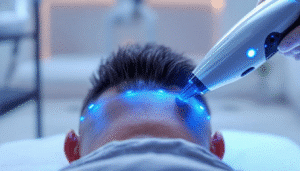Want to know what a hairline transplant looks like? In this article, we share some real ‘hairline transplant before and after’ photos and patient experiences to show you what to expect. To see more transformative photos check out our Before & After gallery.
Key Takeaways
- Before and after photos of hairline transplants effectively demonstrate the significant transformations achievable, fostering patient confidence and realistic expectations about the results.
- Hairline transplants are personalized procedures, with the number of grafts varying based on individual needs, resulting in tailored outcomes that meet specific aesthetic goals.
- Patients typically see gradual hair growth over 12 to 18 months post-transplant, with most achieving natural-looking results and high satisfaction rates with their restored hairlines.
Hairline Transplant Results: Before and After Photos
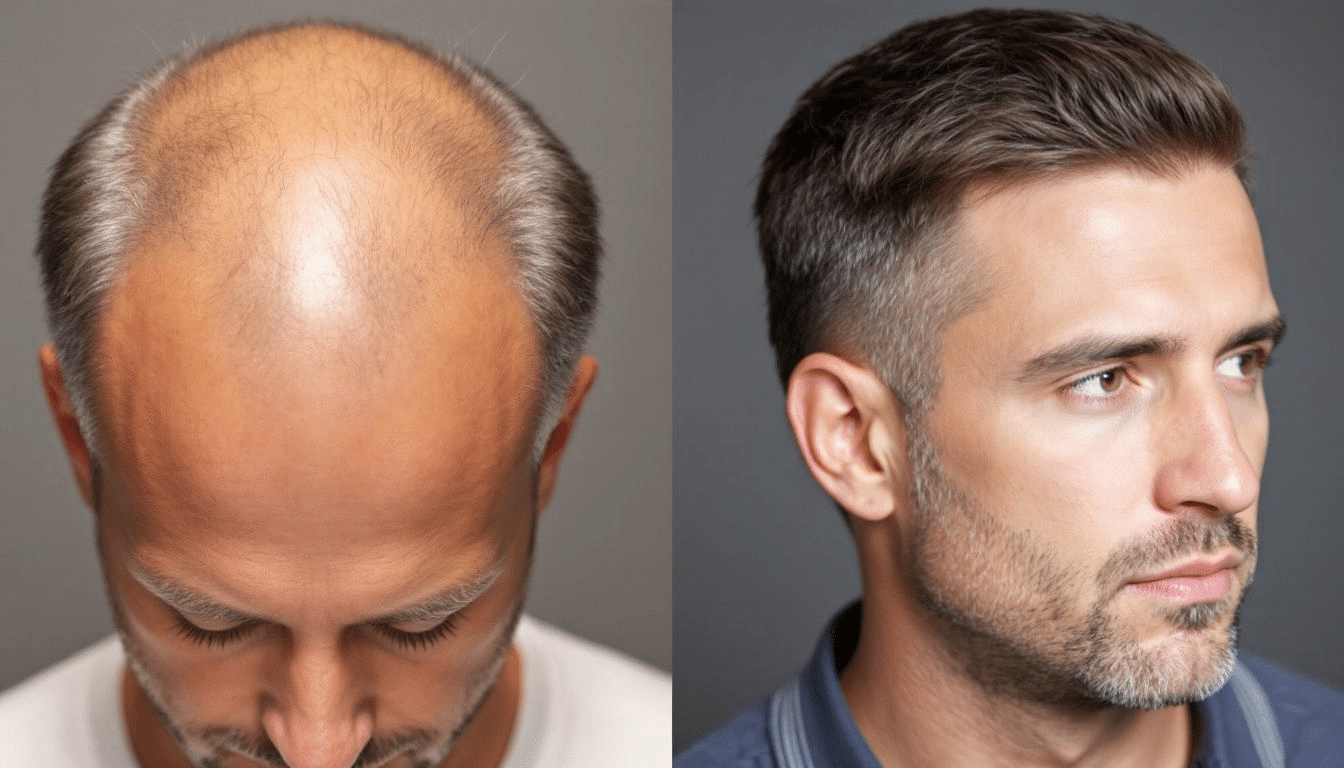
Before and after photos effectively showcase the dramatic changes hairline transplants can bring. Patients often experience noticeable transformations in their hairline appearance, which is a key factor in post-operative satisfaction. For instance, patients showcased in the before and after gallery range in age from 26 to 42 years old, highlighting the diverse demographic of successful outcomes. This variety shows that hairline transplants are effective across different age groups and hair loss patterns.
The number of grafts used in hairline transplants varies, with cases ranging from 1,200 to over 4,000 grafts, demonstrating the personalized nature of hair restoration. This customization ensures that each patient receives the necessary treatment to achieve their desired look. Potential patients should maintain realistic expectations about their transformations, often seeing results six months post-operation. The gradual improvement over time is a testament to the efficacy and natural integration of the transplanted hair.
The before and after photos act as compelling evidence of hairline transplants’ effectiveness. They provide a visual representation of what can be achieved, helping potential patients to envision their own transformation. The incredible results captured in these photos are not just about hair; they represent restored confidence and a renewed sense of self.
Transforming Receding Hairlines
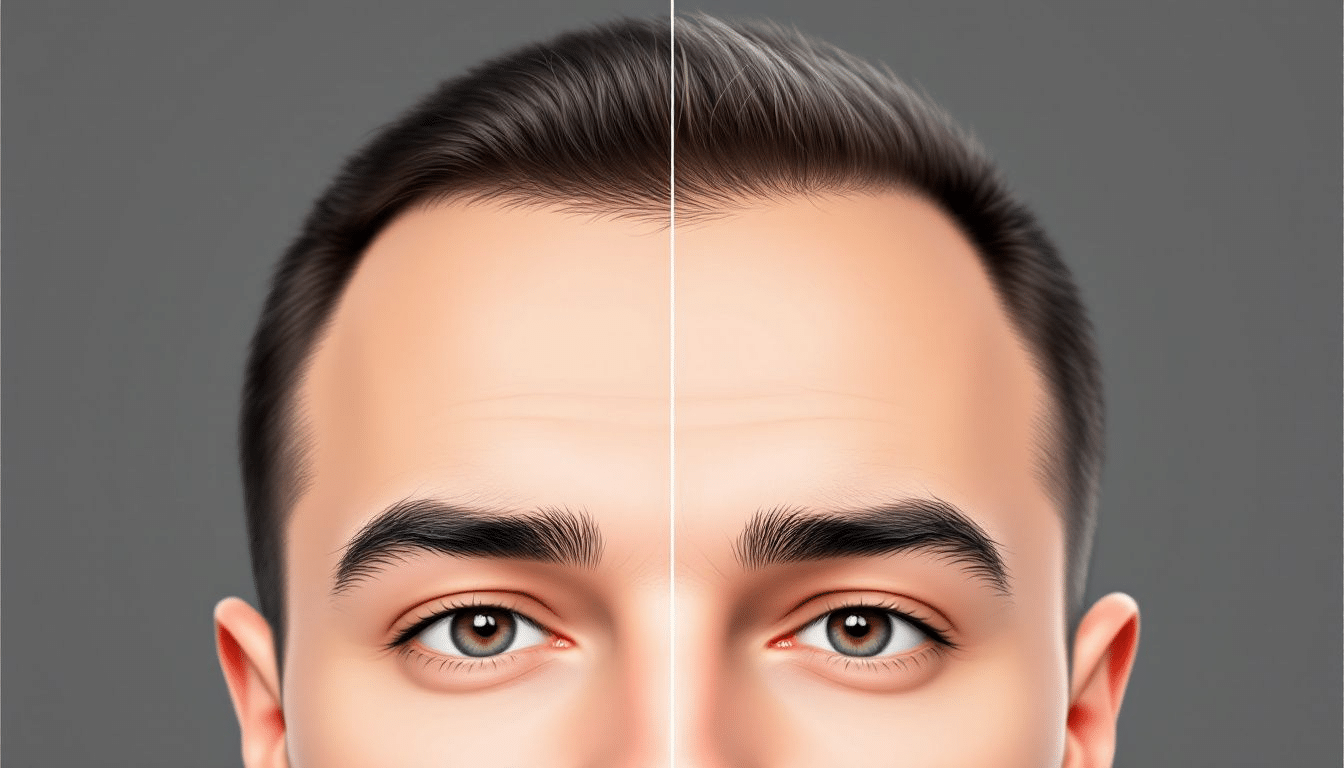
Hairline transplants significantly alter receding hairlines. For example, a 28-year-old patient underwent a 2,500 graft transplant and reported significant improvement in his hairline, with great satisfaction noted after six months. Another patient, who had the same 2,500 graft procedure, observed progressive thickening of his hair over the first year following the transplant. These cases highlight the potential for remarkable improvement in hair density and the restoration of a more youthful appearance.
Common goals for hairline restoration include lowering the hairline and filling in balding areas. Many patients notice significant improvements in hair density after their hairline transplants. The increased density not only enhances the hairline but also contributes to a fuller, more natural look. Addressing thinning hair and receding hairlines can drastically improve an individual’s overall appearance, providing a significant boost in self-confidence.
Transforming a receding hairline requires careful planning and precise execution. Every hair transplant is customized to the patient’s needs, ensuring the new hairline suits their facial features and existing hair. This personalized approach is key to achieving natural-looking results that stand the test of time.
Achieving Natural-Looking Hairlines
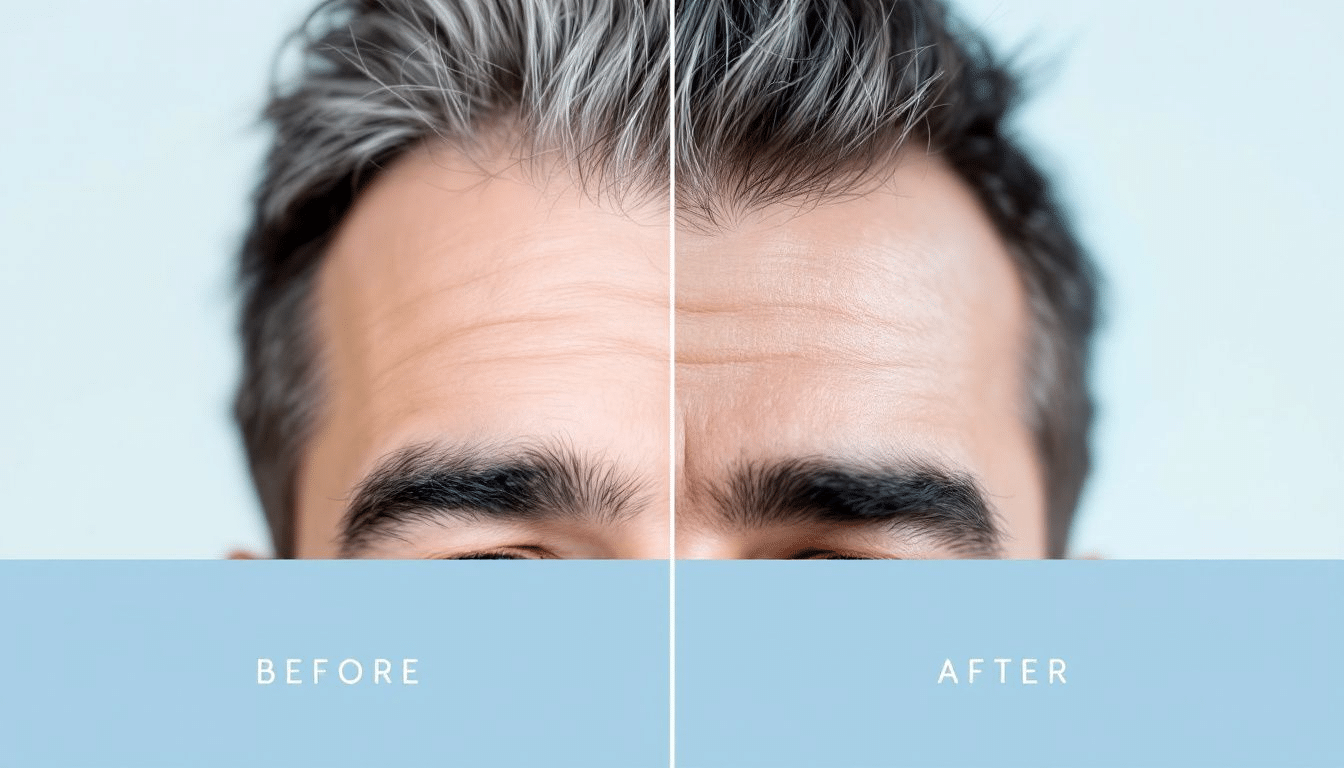
Patients frequently attain a natural-looking hairline post-transplant. A gradual increase in hair density from the hairline to the mid-scalp is essential to mimic natural hair growth. This gradual transition helps the transplanted hair blend seamlessly with the existing hair, creating a cohesive and realistic look. Micrografting techniques, which involve using small follicular units, are effective in creating a natural appearance.
The use of dense packing allows for a high number of grafts to be placed closely together, enhancing hairline fullness. Natural hairlines often display slight irregularities and asymmetries, which are important for a realistic look. These subtle imperfections are carefully recreated during the hair transplant procedure to ensure that the result does not appear too uniform or artificial. A well-planned hair transplant procedure takes into account the unique characteristics of each patient’s hairline.
Natural-looking results stem from a blend of advanced techniques and artistic skill. The surgeon must consider factors such as hair direction, density, and texture to ensure that the transplanted hair mirrors natural hair growth patterns. When executed properly, the results are so natural that even hairstylists may not detect the transplant.
Benefits of Hair Transplant
A hair transplant procedure offers numerous benefits for individuals experiencing hair loss. One of the most significant advantages is the natural-looking results, which can boost self-confidence and self-esteem. Hair transplants are also a long-term solution, as transplanted hair is resistant to genetic hair loss and can last a lifetime. Additionally, hair transplants can be customized to meet individual needs and desires, whether it’s to restore a receding hairline, add density to thinning hair, or create a fuller hairline.
Another benefit of hair transplants is the minimal downtime required. Most patients can return to their normal activities within a few days of the procedure. Furthermore, hair transplants are a relatively painless procedure, with most patients experiencing only mild discomfort during and after the procedure. This combination of natural results, longevity, and convenience makes hair transplants an attractive option for those looking to address hair loss effectively.
How Many Grafts are Needed for a Hairline Transplant?
Factors like hair loss severity, healthy hair, and desired results influence the number of grafts needed for a hairline transplant. Patients have reported various graft counts, ranging from 1,000 to 2,800 grafts for their transplants, reflecting individual needs. For instance, one reported case used 2,500 grafts for the hairline transplant procedure, while another patient required only 1,243 grafts for their procedure. These cases underscore the personalized approach in hair restoration.
Each hair graft generally contains 2 to 5 follicles, forming clusters for transplantation. The graft size for hair transplants averages around 1 to 4 strands of hair per graft. The number of grafts needed can differ slightly between the FUT and FUE hair transplant methods, but the overall graft count remains similar. This consistency in the final result is maintained regardless of the technique used.
Before and after images can be sorted based on the total number of grafts used in each procedure, showcasing the results of the transplant. These images offer valuable insight into achievable results with varying graft counts, aiding potential patients in setting realistic expectations.
Suitable Candidates for Hairline Transplant
Individuals under 25 are often encouraged to wait until their hair loss pattern becomes stable before considering a hair transplant. Candidates typically aged between 30 and 50 are considered ideal, as their hair loss is usually stabilized by this age and they often have healthy hair. There is no strict upper age limit for hair transplants; individuals in their 50s, 60s, or even 70s can be suitable if they have adequate donor hair. This flexibility ensures that a wide range of individuals can benefit from hair restoration procedures.
Patients experiencing ongoing hair loss may need to consider this factor when determining current and future graft requirements. Stable hair loss is crucial for hair transplant candidates. The overall health and hair loss pattern of an individual are more critical than age in determining candidacy for hair transplants. Ensuring that the patient has a stable hair thinning pattern helps in achieving long-lasting results.
Advanced hairline designs should be customized to each patient’s facial features and hair characteristics for optimal results. For women, a different measurement scale (Ludwig Scale) is used to assess hair loss and determine the required grafts. This gender-specific approach ensures that both men and women receive personalized treatment that addresses their unique needs.
Hair Restoration for Women
Hair restoration for women is a specialized field that requires expertise and a deep understanding of female hair loss patterns. Women often experience thinning hair across the entire scalp, rather than a receding hairline like men. Hair restoration options for women, including hair transplants and hair thickening treatments, are designed to address these unique challenges.
The required number of grafts and their placement are crucial for a successful hair transplant procedure in women. Experienced doctors will work with you to create a customized treatment plan that meets your individual needs and desires. This personalized approach ensures that the results are natural-looking and tailored to your specific hair loss pattern. Additionally, many clinics offer a free, no-obligation consultation to discuss your hair restoration options and answer any questions you may have, making it easier to take the first step towards regaining your confidence.
Eyebrow and Facial Hair Restoration
Eyebrow and facial hair restoration are specialized procedures that require expertise and precision. Clinics offering these services often use advanced methods like Hair Stem-cell Transplantation (HST) to achieve beautiful outcomes with a short recovery time. This method is particularly effective for eyebrow transplantation, allowing for natural-looking results that enhance facial symmetry and expression.
Facial hair transplantation, including beard reconstruction, also benefits from the HST method. This technique leaves almost no scars and ensures that the implanted hairs grow in the correct shape and direction. Whether you’re looking to reconstruct eyebrows or enhance your beard, the precision and expertise involved in these procedures ensure that the results are both natural and aesthetically pleasing.
The Hairline Transplant Procedure Step-by-Step
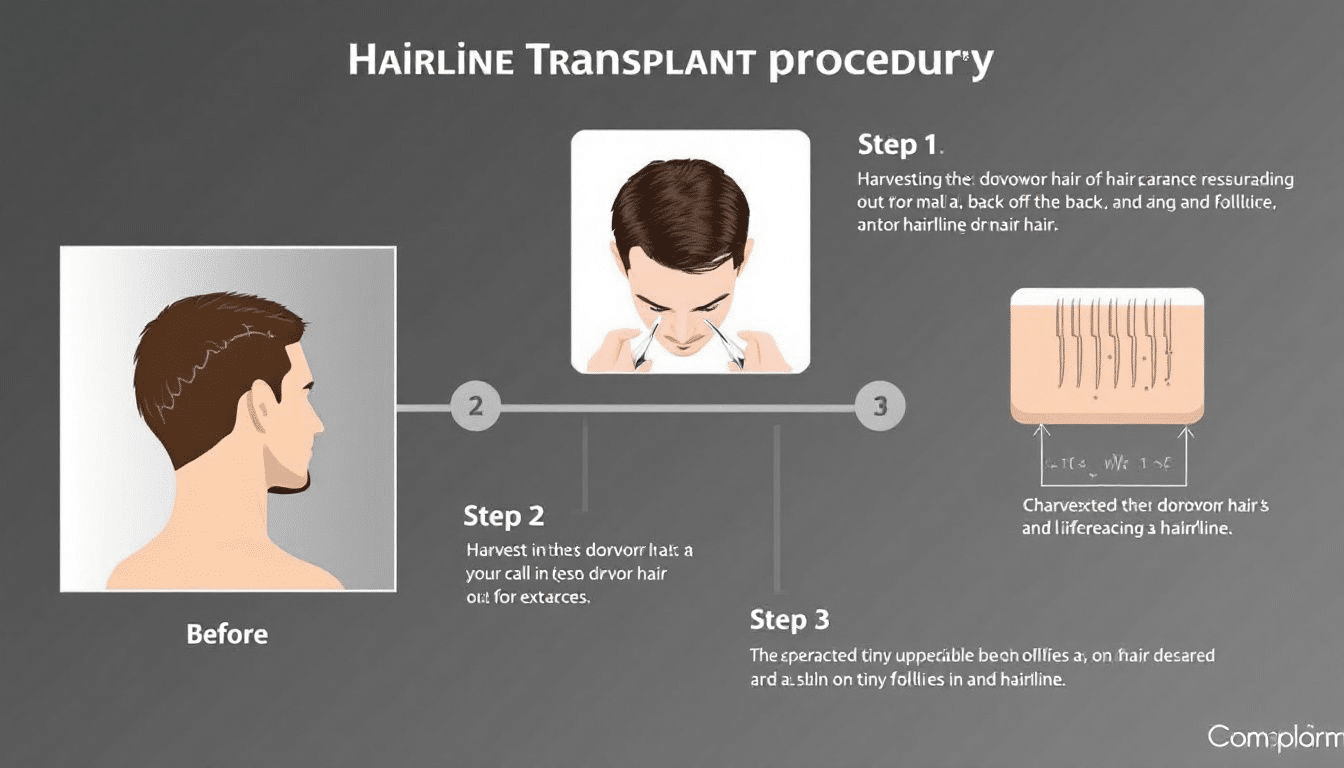
The process of a hairline transplant involves several critical steps, each designed to ensure the success of the procedure. The initial consultation assesses the patient’s scalp and discusses expectations for the hairline transplant. This step lays the foundation for the process, enabling the surgeon to understand and evaluate the patient’s goals.
On surgery day, the donor area is marked and partially shaved, preserving the surrounding hair. This careful preparation helps to ensure that the transplanted hair will blend seamlessly with the existing hair.
Post-surgery care instructions are essential for ensuring optimal healing and successful hair growth following the transplant. These steps collectively contribute to the overall success of the hair transplant procedure.
Initial Consultation
During the initial consultation, the surgeon evaluates the scalp condition and discusses the patient’s desired outcomes. This first meeting involves discussing the patient’s expectations and potential outcomes based on their unique situation. It serves as an opportunity for the patient to learn about the hairline transplant process and for the surgeon to understand the patient’s needs.
This consultation is a critical step in the hair transplant journey as it sets the stage for the entire procedure. By thoroughly understanding the patient’s goals and the condition of their scalp, the surgeon can develop a personalized treatment plan that maximizes the chances of achieving natural-looking results.
Surgery Day
On surgery day, the donor area is marked and partially shaved, preserving the surrounding hair. This careful preparation ensures that the transplanted hair will blend seamlessly with the existing hair. The precise marking and shaving of the donor area are critical for harvesting the hair follicles needed for transplantation.
The actual hair transplant procedure involves the extraction of hair follicles from the donor area and their meticulous placement into the recipient area. This process requires a high level of skill and precision to ensure that the transplanted hair grows naturally and aligns with the patient’s existing hair growth patterns. Hair transplant surgery is a critical step in achieving these results.
Post-Surgery Care
After the hair restoration procedure, patients receive specific post-operative care instructions to promote optimal healing and hair growth. Post-operative care typically includes specific instructions for medication and follow-up appointments to monitor recovery. Follow-up appointments ensure the transplanted hair grows as expected and address potential complications promptly.
Patients are advised to avoid strenuous activities during the initial recovery phase to promote healing. Following post-operative care instructions and activity restrictions is vital for achieving the best results after the hairline transplant. These guidelines help to ensure that the newly transplanted hair follicles are not disturbed and can establish themselves in the recipient area.
Proper post-surgery care is essential for achieving the desired outcome of the hair transplant. Adhering to the surgeon’s instructions and attending follow-up appointments maximizes the chances of a successful, natural-looking result.
Choosing the Right Hair Transplant Clinic
Choosing the right hair transplant clinic is a crucial decision that can affect the success of your hair restoration procedure. Here are some factors to consider when selecting a hair transplant clinic:
- Experience: Look for a clinic with experienced doctors and technicians who have a proven track record of successful hair transplants.
- Expertise: Ensure that the clinic has expertise in hair restoration for your specific needs, whether it’s hair transplants, hair thickening treatments, or eyebrow and facial hair restoration.
- Customization: Choose a clinic that offers customized treatment plans tailored to your individual needs and desires.
- Technology: Look for a clinic that uses state-of-the-art technology, such as the HST method, to ensure the best possible results.
- Reviews: Check online reviews and testimonials from past patients to get an idea of the clinic’s reputation and success rate.
By considering these factors, you can make an informed decision and choose a hair transplant clinic that meets your needs and provides the best possible results. This careful selection process ensures that you receive high-quality care and achieve the natural-looking results you desire.
Realistic Expectations and Final Results

Complete hair transplant results typically take 12 to 18 months to fully manifest. Patients can expect early hair growth within 3 to 4 months after the procedure. The first significant visible growth typically starts around the 6-month mark. This gradual development allows patients to adjust to their new look and ensures the final results appear natural.
After 12 months, most patients can treat and style their newly grown hair just like natural hair. Patients at 12 months post-transplant often express satisfaction with their hair restoration results. Initially, new hairs may appear thin and wispy, similar to body hair. The maturation and thickening of transplanted hair can continue up to 18 months post-surgery, contributing to new hair growth.
Managing patient expectations about the final hairline design is crucial for post-transplant satisfaction. A hair transplant can restore a natural hairline and significantly boost self-confidence. At least 90% of patients report a successful outcome from their hair transplant. These positive outcomes highlight the transformative potential of hairline transplants.
Cost of Hairline Transplants in 2025
In 2025, hair transplant costs in Turkey typically range from $1,500 to $3,500, while in the United States, the average could be between $4,000 and $15,000. Factors such as the applied technique, number of grafts needed, and clinic’s reputation affect the price. The type of procedure chosen, such as FUE or FUT, also significantly impacts the overall cost of hairline transplants.
Some Turkish clinics offer all-inclusive packages, covering surgery, accommodation, and transport, which can help manage overall expenses. These packages provide a convenient and cost-effective option for international patients seeking hair restoration. Patients in the USA may face additional hidden costs for consultations and aftercare, which are often bundled in packages offered by clinics in Turkey.
Understanding the costs associated with hairline transplants is essential for making an informed decision. By considering factors such as location, technique, and package options, patients can choose a solution that fits their budget and meets their hair restoration needs.
Summary
Hairline transplants offer a viable solution for those struggling with hair loss, providing natural-looking results and boosting self-confidence. The process involves a detailed consultation, careful surgical techniques, and diligent post-operative care to ensure the best outcomes. By understanding the journey and setting realistic expectations, patients can achieve remarkable transformations that significantly improve their appearance and quality of life.
Whether you’re considering a hair transplant for the first time or looking to enhance previous results, exploring the wealth of before and after photos and understanding the detailed process can help you make an informed decision. Embrace the possibility of a fuller, natural-looking hairline and take the first step towards a renewed sense of self.
Frequently Asked Questions
Can a hair transplant fix hairline?
A hair transplant can effectively fix a hairline, offering options from simple filling to hairline lowering techniques. This surgical intervention can significantly enhance self-confidence and improve appearance.
How much does a hairline transplant cost?
A hairline transplant typically costs between $7,000 and $10,000, depending on individual needs and the number of grafts required. It is advisable to obtain a detailed estimate during a consultation.
How long does it take to see the final results of a hairline transplant?
The final results of a hairline transplant typically become evident between 12 to 18 months after the procedure. Initial hair growth may begin within 3 to 4 months, with more noticeable results appearing around the 6-month mark.
What factors determine the number of grafts needed for a hairline transplant?
The number of grafts needed for a hairline transplant primarily depends on the severity of hair loss, hair health, and the desired outcome. Typically, patients require between 1,000 to 2,800 grafts, with the chosen procedure type also playing a role in the final count.
Who is a suitable candidate for a hairline transplant?
A suitable candidate for a hairline transplant is typically an individual aged between 30 and 50 with stabilized hair loss and good overall health. However, older individuals may also qualify if they have sufficient donor hair.

